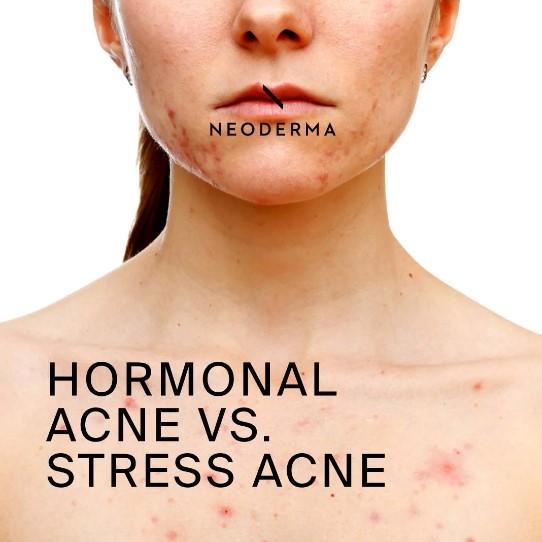The Connection Between Stress and Acne: How Stress Affects Your Skin

If you've ever noticed a sudden breakout during a hectic week or before a big exam, you’re not alone. Stress and acne often go hand-in-hand, with stress being one of the most common triggers for skin issues. Understanding how stress affects different areas of your skin can help you manage breakouts more effectively. In this post, we’ll explore how stress triggers acne, where stress acne typically appears, and how it compares to Hormonal Acne. Plus, you’ll find tips on managing and reducing stress to keep your skin clear.
What Is Stress Acne?
Stress acne refers to breakouts that are triggered or worsened by stress. When you’re stressed, your body undergoes several physiological changes. One of the key players in this process is the hormone cortisol. During times of stress, your body releases more cortisol, which in turn increases oil production in your skin. Excess oil (sebum) can clog pores, leading to inflammation and acne.
Stress doesn’t just increase oil production; it can also weaken your skin’s natural barrier, making it more prone to irritation and less able to heal properly. This combination of factors is why stress-related breakouts often seem more stubborn and appear during particularly stressful times, like exams, work deadlines, or big life events.
How Does Stress Cause Acne?
The body’s stress response is complex, but when it comes to acne, the key mechanism is the increase in cortisol and the overactivation of the sebaceous (oil) glands. Here’s how it works:
Cortisol Surge: Stress causes your adrenal glands to release more cortisol, known as the “stress hormone.” This hormone signals your skin to produce more oil.
Oil Production: Excess oil on the skin clogs pores, providing a breeding ground for bacteria and resulting in inflamed pimples or cystic acne.
Weakened Skin Barrier: Chronic stress weakens the skin’s natural defenses, making it less effective at repairing damage or keeping irritants out, which leads to longer-lasting breakouts.
In addition to these physiological changes, stress can also impact your overall health habits. Stress often leads to poor sleep, an unbalanced diet, and lack of exercise—all of which can contribute to worsened acne.
Where Is Stress Acne Located?
Stress acne tends to appear in specific areas of the face, and recognizing these "stress acne areas" can help you identify if your breakouts are related to stress. Common areas include:
Forehead: This is one of the most stress-sensitive areas. Stress can cause the body to overproduce oil, leading to clogged pores on the forehead.
Chin and Jawline: Stress acne often manifests along the lower part of the face, including the chin and jawline. This is partly because stress impacts the hormone cortisol, which interacts with the androgen hormones, increasing oil production in this area.
Temples and Hairline: Breakouts in these areas can be linked to stress, especially if you notice them alongside tension headaches or periods of mental strain.
Hormonal Acne vs. Stress Acne: What’s the Difference?
While both hormonal and stress acne involve internal triggers, they have different root causes and can appear in slightly different areas of the skin.
Hormonal Acne:
Trigger: Hormonal imbalances, particularly fluctuating levels of estrogen, progesterone, and testosterone, are the main culprits.
Location: Hormonal acne usually appears around the lower face, including the chin, jawline, and neck. It often coincides with the menstrual cycle in women.
Nature of Breakouts: Hormonal acne tends to be deeper, cystic, and more inflamed.
Stress Acne:
Trigger: Increased cortisol production due to stress.
Location: Common areas for stress acne include the forehead, temples, and chin, though it can occur anywhere.
Nature of Breakouts: Stress acne often presents as smaller, more superficial pimples and can be associated with oiliness and inflammation.
Both types of acne can overlap, but paying attention to stress acne placement can help you differentiate between the two.
Managing Stress Acne: Tips and Advice
Managing stress-related breakouts can feel frustrating, especially when the stress itself seems hard to avoid. However, there are ways to minimize its impact on your skin:
1. Stress-Reduction Techniques
Practice Mindfulness or Meditation: Stress-reduction techniques like meditation, yoga, or deep breathing can lower cortisol levels and calm both your mind and skin.
Exercise Regularly: Physical activity helps reduce stress and promotes better circulation, which can benefit your skin.
Prioritize Sleep: Sleep is essential for skin regeneration. Aim for 7-9 hours of restful sleep to support your skin’s healing process.
2. Skincare Routine for Stress-Prone Skin
Keep Skin Clean: Use a gentle cleanser twice a day to remove excess oil and dirt.
Hydrate: Opt for a non-comedogenic moisturizer to maintain your skin barrier.
Spot Treatment: Use targeted treatments with salicylic acid or benzoyl peroxide to clear clogged pores and reduce inflammation.
3. When to Seek Professional Help
If your stress acne becomes severe or persistent, consider consulting a dermatologist. Prescription treatments like retinoids, antibiotics, or hormonal therapies may be necessary to bring it under control.
Final Thoughts
Stress acne can feel like an inevitable part of life, but understanding how stress affects different areas of your skin can help you manage it more effectively. By adopting stress-reduction practices, maintaining a consistent skincare routine, and knowing when to seek professional advice, you can keep stress-related breakouts in check.
Remember, stress acne is manageable, and you’re not alone in facing it. With the right approach, you can regain control over both your stress and your skin.
Post Your Ad Here
Comments